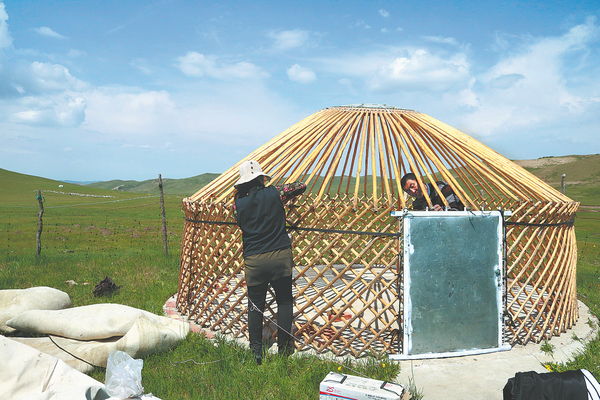

Every year in mid-June, many of the ethnic herders in the heritage site, which is home to about 15,000 people, move with their livestock to summer grazing grounds in the north, in a journey of up to three days covering 100 kilometers along three major waterways near the Greater Khingan Mountains.
The annual drive is staggered into groups of three to eight households at any one time, each with about 1,000 sheep and 300 cattle, to minimize impact on the environment, says Zhou Wenlong, deputy director of the Ar Horqin agricultural cultural heritage protection center.
In the summer area spread across more than 173,000 hectares, herders set up traditional Mongolian yurts and take care not to overgraze their animals on the shared grasslands.
"There are no fenced plots, which means the herders enjoy a natural setting that supports the interdependent biodiversity of the area," Zhou says.
When the weather gets cold, Ar Horqin's herders drive their livestock down south back to their wintering grounds covering 160,000 hectares.
"It's a crucial cycle reflecting the wisdom of their predecessors, who realized the importance of achieving a fine balance between human development and the environment," Zhou says.
In July last year, President Xi Jinping sent a congratulatory letter to the World Conference on Globally Important Agricultural Heritage Systems, emphasizing that it is the common responsibility of humankind to protect agricultural heritage.
China has actively responded to the program initiated by the FAO and the country has been protecting and inheriting agricultural heritage, Xi highlighted.
Ar Horqin's grassland nomadic system is based on traditional knowledge and accumulated generations of experience, with Mongolian herders developing a healthy ecosystem and the special natural environment also giving birth to a distinct culture, according to the FAO.
For master craftsman Sainduuren, 58, the wooden ox carts he creates help maintain Mongolians' links with the land.
"My carts are an extension of the agricultural-cultural heritage here, nurtured by the grasslands," says Sainduuren, who is a national-level inheritor of intangible cultural heritage involving the ox carts, also known as "lele" carts.
Ar Horqin's heritage listing allows knowledge of the carts, like other ethnic Mongolian customs and practices, ranging from dairy food and meat production to folk festivals and yurt dwellings, to be preserved and passed down, he says.